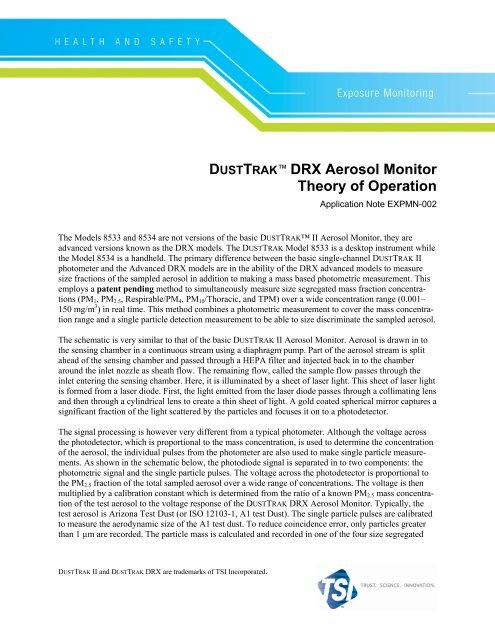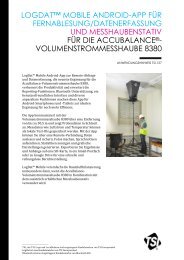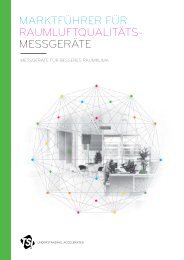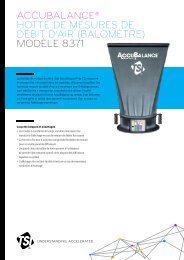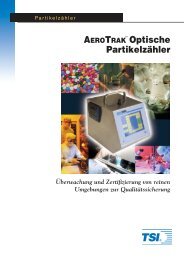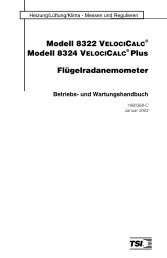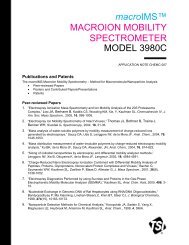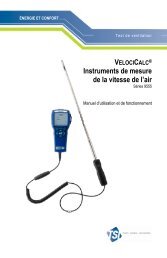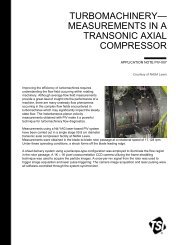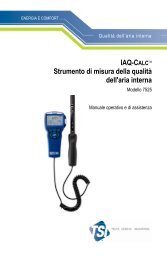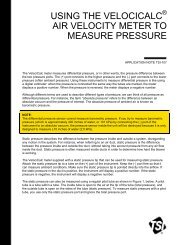DustTrak DRX Aerosol Monitor Theory of Operation ... - TSI
DustTrak DRX Aerosol Monitor Theory of Operation ... - TSI
DustTrak DRX Aerosol Monitor Theory of Operation ... - TSI
Create successful ePaper yourself
Turn your PDF publications into a flip-book with our unique Google optimized e-Paper software.
DUSTTRAK II and DUSTTRAK <strong>DRX</strong> are trademarks <strong>of</strong> <strong>TSI</strong> Incorporated.<br />
Exposure <strong>Monitor</strong>ing<br />
DUSTTRAK <strong>DRX</strong> <strong>Aerosol</strong> <strong>Monitor</strong><br />
<strong>Theory</strong> <strong>of</strong> <strong>Operation</strong><br />
Application Note EXPMN-002<br />
The Models 8533 and 8534 are not versions <strong>of</strong> the basic DUSTTRAK II <strong>Aerosol</strong> <strong>Monitor</strong>, they are<br />
advanced versions known as the <strong>DRX</strong> models. The DUSTTRAK Model 8533 is a desktop instrument while<br />
the Model 8534 is a handheld. The primary difference between the basic single-channel DUSTTRAK II<br />
photometer and the Advanced <strong>DRX</strong> models are in the ability <strong>of</strong> the <strong>DRX</strong> advanced models to measure<br />
size fractions <strong>of</strong> the sampled aerosol in addition to making a mass based photometric measurement. This<br />
employs a patent pending method to simultaneously measure size segregated mass fraction concentrations<br />
(PM1, PM2.5, Respirable/PM4, PM10/Thoracic, and TPM) over a wide concentration range (0.001–<br />
150 mg/m 3 ) in real time. This method combines a photometric measurement to cover the mass concentration<br />
range and a single particle detection measurement to be able to size discriminate the sampled aerosol.<br />
The schematic is very similar to that <strong>of</strong> the basic DUSTTRAK II <strong>Aerosol</strong> <strong>Monitor</strong>. <strong>Aerosol</strong> is drawn in to<br />
the sensing chamber in a continuous stream using a diaphragm pump. Part <strong>of</strong> the aerosol stream is split<br />
ahead <strong>of</strong> the sensing chamber and passed through a HEPA filter and injected back in to the chamber<br />
around the inlet nozzle as sheath flow. The remaining flow, called the sample flow passes through the<br />
inlet entering the sensing chamber. Here, it is illuminated by a sheet <strong>of</strong> laser light. This sheet <strong>of</strong> laser light<br />
is formed from a laser diode. First, the light emitted from the laser diode passes through a collimating lens<br />
and then through a cylindrical lens to create a thin sheet <strong>of</strong> light. A gold coated spherical mirror captures a<br />
significant fraction <strong>of</strong> the light scattered by the particles and focuses it on to a photodetector.<br />
The signal processing is however very different from a typical photometer. Although the voltage across<br />
the photodetector, which is proportional to the mass concentration, is used to determine the concentration<br />
<strong>of</strong> the aerosol, the individual pulses from the photometer are also used to make single particle measurements.<br />
As shown in the schematic below, the photodiode signal is separated in to two components: the<br />
photometric signal and the single particle pulses. The voltage across the photodetector is proportional to<br />
the PM2.5 fraction <strong>of</strong> the total sampled aerosol over a wide range <strong>of</strong> concentrations. The voltage is then<br />
multiplied by a calibration constant which is determined from the ratio <strong>of</strong> a known PM2.5 mass concentration<br />
<strong>of</strong> the test aerosol to the voltage response <strong>of</strong> the DUSTTRAK <strong>DRX</strong> <strong>Aerosol</strong> <strong>Monitor</strong>. Typically, the<br />
test aerosol is Arizona Test Dust (or ISO 12103-1, A1 test Dust). The single particle pulses are calibrated<br />
to measure the aerodynamic size <strong>of</strong> the A1 test dust. To reduce coincidence error, only particles greater<br />
than 1 µm are recorded. The particle mass is calculated and recorded in one <strong>of</strong> the four size segregated
mass fractions (PM1, PM2.5, Respirable/PM4, PM10/Thoracic, and TPM). The size segregated mass<br />
concentration is obtained as follows:<br />
PM1 = PM2.5 – PM1-2.5<br />
PM2.5 = Photometric signal × calibration factor<br />
Respirable / PM4 = PM2.5 + PM2.5-4<br />
PM10 / Thoracic = PM4 + PM4-10<br />
TPM = PM10+ PM>10<br />
Laser Diode<br />
Exhaust<br />
Orifice<br />
Laser<br />
Beam<br />
Mirror<br />
Beam Shaping<br />
Optics<br />
<strong>Aerosol</strong> Measurement<br />
Flowmeter<br />
HEPA Filter<br />
Sheath Air<br />
Pump<br />
<strong>Aerosol</strong> Inlet<br />
Light Trap<br />
Viewing<br />
Volume<br />
Photo<br />
Detector<br />
Gravimetric<br />
Filter<br />
Protection<br />
Filter<br />
Dampening<br />
Chamber<br />
Optics<br />
Chamber<br />
-2-<br />
Signal Acquisition and Processing<br />
Single Particle<br />
Pulses<br />
Photometric<br />
Voltage<br />
Size Segregated<br />
Mass Concentration<br />
(eg. PM1, PM2.5, PM4 & PM10)<br />
The algorithms used by the DUSTTRAK <strong>DRX</strong> <strong>Aerosol</strong> <strong>Monitor</strong> yield a mass measurement technique that<br />
is superior to either a basic photometer or Optical Particle Counter (OPC). While photometers can be used<br />
at high mass concentrations, they do not give any size information (unless used with size selective inlet<br />
conditioners) and significantly underestimate particle mass contributed by large particles. On the other<br />
hand, OPCs provide size information, however they cannot be used at high mass concentration. The<br />
DUSTTRAK <strong>DRX</strong> <strong>Aerosol</strong> <strong>Monitor</strong> is able to combine the advantages <strong>of</strong> both the measurement techniques<br />
to improve the overall accuracy <strong>of</strong> the mass measurement.<br />
The DUSTTRAK <strong>DRX</strong> <strong>Aerosol</strong> <strong>Monitor</strong> is able to measure mass concentrations with greater accuracy<br />
because <strong>of</strong> its ability to measure single particles >1 µm, since the photometric signal is less sensitive to<br />
large particles. In addition, the DUSTTRAK <strong>DRX</strong> compensates for coincidence error using a dead-time<br />
correction algorithm. Furthermore, the DUSTTRAK <strong>DRX</strong> <strong>Aerosol</strong> <strong>Monitor</strong> converts the single particle<br />
pulses to aerodynamic size by proprietary factory or custom calibrations, significantly reducing mass<br />
calculation errors due to particle density, refractive index and shape on the calculated mass concentration.<br />
As a result, the DUSTTRAK <strong>DRX</strong> <strong>Aerosol</strong> <strong>Monitor</strong> size segregated mass fraction measurement has the size<br />
resolution <strong>of</strong> an OPC along with a much higher mass concentration range like a typical photometer.
Although the DUSTTRAK <strong>DRX</strong> monitor comes with a couple <strong>of</strong> calibration impactors, they are recommended<br />
for use only during custom calibrations. The greatest advantage <strong>of</strong> using the DUSTTRAK <strong>DRX</strong><br />
<strong>Aerosol</strong> <strong>Monitor</strong> over other photometers in the market including the DUSTTRAK II <strong>Aerosol</strong> <strong>Monitor</strong> basic<br />
is the lack <strong>of</strong> need for a size-selective inlet conditioner. PM1, PM2.5, Respirable/PM4, PM10/Thoracic and<br />
TPM fractions can all be measured simultaneously without the use <strong>of</strong> any size-selective inlet conditioners.<br />
To improve the accuracy <strong>of</strong> the mass measurement, the unit can be calibrated with gravimetric sample(s)<br />
by conducting side-by-side comparisons with the DUSTTRAK <strong>DRX</strong> <strong>Aerosol</strong> <strong>Monitor</strong> readings to gravimetric<br />
samples. On the Desktop Model 8533, a 37-mm filter cassette sampler can be inserted in-line with<br />
the aerosol stream at the outlet <strong>of</strong> the optics chamber allowing the user to perform a gravimetric analysis<br />
without the need for using an external pump and filter holder.<br />
At <strong>TSI</strong>, the DUSTTRAK <strong>DRX</strong> <strong>Aerosol</strong> <strong>Monitor</strong> is calibrated against a reference photometer (Model 8587)<br />
that is gravimetrically calibrated to ISO 12103-1, A1 test dust (Arizona Test Dust). This test dust has a<br />
wide size distribution covering the entire size range <strong>of</strong> the DUSTTRAK <strong>DRX</strong> <strong>Aerosol</strong> <strong>Monitor</strong> and is<br />
representative <strong>of</strong> a wide variety <strong>of</strong> ambient aerosols.<br />
The optics inside the DUSTTRAK <strong>DRX</strong> <strong>Aerosol</strong> <strong>Monitor</strong> is kept clean by surrounding the aerosol stream<br />
with a sheath <strong>of</strong> clean filtered air. This sheath air confines the aerosol to a narrow stream and prevents<br />
particles from circulating around the optics chamber and depositing on the optics. It reduces coincidence<br />
errors in the single particle measurements and make the pulse height more uniform by retaining the<br />
particles within the Gaussian pr<strong>of</strong>ile <strong>of</strong> the laser beam that produces more uniform pulse widths regardless<br />
<strong>of</strong> where the particles enter the inlet nozzle. Sheath flow also improves the response time <strong>of</strong> the<br />
instrument. The user can also access the sheath and main flow filters that need to be changed periodically<br />
to maintain the flow ratio between the sample flow and sheath flow a constant. The DUSTTRAK <strong>DRX</strong>’s<br />
firmware will automatically detect the life <strong>of</strong> those filters and warn the user to change them before the<br />
pressure drop across those filters become excessive.<br />
-3-
<strong>TSI</strong> Incorporated – 500 Cardigan Road, Shoreview, MN 55126 U.S.A<br />
USA Tel: +1 800 874 2811 E-mail: info@tsi.com Website: www.tsi.com<br />
UK Tel: +44 149 4 459200 E-mail: tsiuk@tsi.com Website: www.tsiinc.co.uk<br />
France Tel: +33 491 95 21 90 E-mail: tsifrance@tsi.com Website: www.tsiinc.fr<br />
Germany Tel: +49 241 523030 E-mail: tsigmbh@tsi.com Website: www.tsiinc.de<br />
India Tel: +91 80 41132470 E-mail: tsi-india@tsi.com<br />
China Tel: +86 10 8260 1595 E-mail: tsibeijing@tsi.com<br />
Contact your local <strong>TSI</strong> Distributor or visit our website www.tsi.com for more detailed specifications.<br />
5/08 Copyright © 2008 by <strong>TSI</strong> Incorporated Printed in U.S.A


